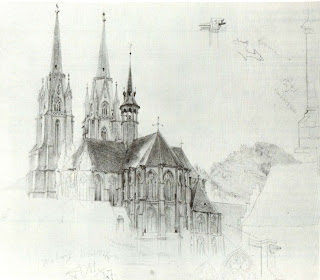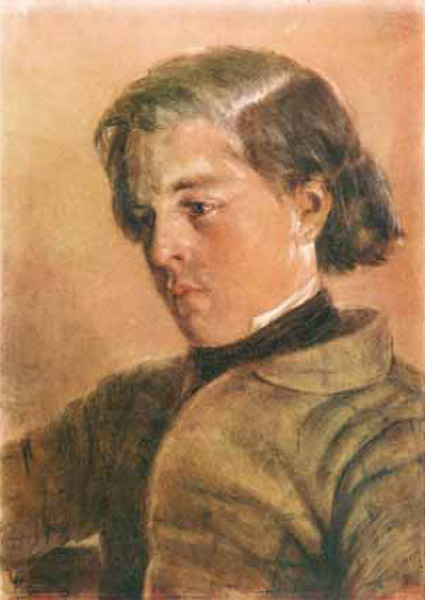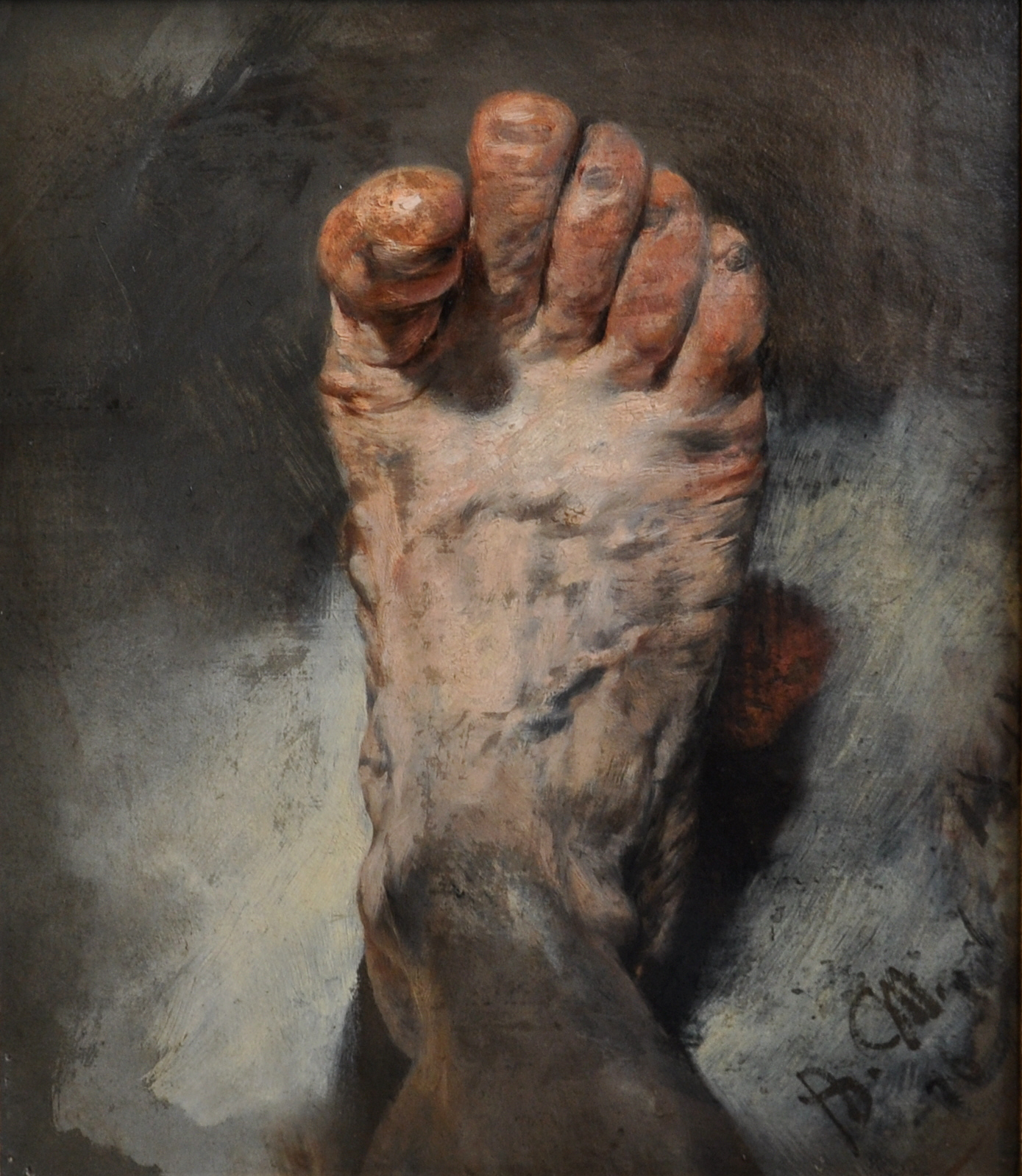Memories of Carl Johann Arnold Part II:
In the next year, in 1847, it became
possible for my father as chairman of the hessian Kunstverein*
(*ChSch "Since the beginning of the 19th
century, Kunstvereine (member based art societies with exhibitions
spaces) are the most important institutions for the production,
exhibition and communication of contemporary art in Germany. Today
there are over 250 Kunstvereine, some of them being big exhibition
spaces…" ) to obtain a bigger comission for Menzel.
One
expected to bring a big oil painting to it's execution and Menzel
chose a preliminary sketch of the „Meeting of Gustav Adolf and his
wife“ as a theme.
 |
| Adolph Menzel, oil study "the Meeting of Gustav Adolf and his wife“ |
Because the disposable money wasn't enough for a huge oilpainting and furthermore a subject from the
hessian history was preferred, one eventually agreed in comissioning
Menzel with a Karton („cartoon“) with lifesized figures ,which
should show the entering of Sophie von Brabant with her little son in
Marburg.
On a sidenote: Menzel did buy it back later again from the
Kunstverein.
The price was set to 800 Taler. Menzel
agreed and arrived with a lot of prestudies in August at our
place in Kassel. My father had made arrangements before his arrival, and had
allready reserved a big room within our house at Wilhelmshöher Platz
4 and brought a canvas about to be stretched along the complete long
side of the room.
 | |
| drawing by C.J. Arnold: Menzel, working on the Kassel Karton |
Before the work should begin there had
to be studies been made of the territory in Marburg as well as the
characteristic shwalmian(?*) (*ChSch: in German it's „schwälmisch“-
a local kind of people in Hessen, here as an attribute – couldn't
find a proper translation) type of peasants.
 |
| Adolph Menzel, study of a hessian peasant, 1847 |
I was very delighted that
Menzel took me with him, where I had to busily study with him. Above
all he was fascinated by the magnificent building of the
Elisabethkirche, after which he did, during very high temperatures, a
drawing. Then it was the turn to draw the inside, the many grand
woodcarvings, funerary monuments, sculptures, eventually the archive,
to make it short, the few days that were reserved for our stay just
flew by and it had to be thought about our return journey, as
reluctantly as it was.
 | |
| the Elisabethkirche, 1847 |
 |
| Statues of Elisabethkirche, 1847 |
 |
| Statues of Elisabethkirche, 1847 |
After returning to Kassel Menzel began
immediately to execute the work. All necessairy costumes were
gathered , as well as modells, as which the three of us siblings
often had to assist as well. To not tire too much on the huge
painting he also did other works inbetween and painted several
portraits in pastells and oils. Thus the portrait of my father under
lamplights in oils, then mine, the portraits of my two sisters and
the french legation councilor v. Rothan came into being.
 |
| drawing by C.J. Arnold,: Menzel working on the portrait of Carl Heinrich Arnold |
| Portrait of Carl Heinrich Arnold, oil, 1847 |
 |
| Portrait of Carl Johann Arnold, pastells, 1847 |
 |
| Portrait of Caroline Arnold, pastells, 1847 |
 |
| Portrait of Friederike "Frtitzchen" Arnold, pastells, 1847 |
Because I
took riding lessons during that time I had to pose for the riders in
the picture and executed the several poses at the riding school. In
the evenings we often went to the theatre and visited concerts. As
well in our family music was played a lot, and here Menzel got to
know the famous composer Louis Spohr, who delighted him through his
ingenious playing on the violin. Through these muscial evenings he
was inspired to create several ink drawings. Because of all these
works inbetween and manyfold socialities the completion of the Karton
was strongly affected, thus the initially planned eight weeks turned
into the same amount of months so that Menzel had to extend his stay
with us from the beginning of August 1847 till the end of March 1848,
before the painting was finished. Out of this he wrote underneath a
drawing that he did for my sister for Christmas: „by Menzel, who is
still around“. Because I shared the room with him it also happened
that I saw Menzel, when I woke up suddenly, in front of me, while he
was drawing after me saying: „You just woke up five minutes too
early!“
Oftentimes I watched that he quickly
noted a special lighting or movement, no matter how late it allready
was. Menzel was overly anxious about fire and lights and he always
did walk through his room and the atelier in the dark, he examined as
well the sleeping room elaborately, watching underneath the bed
wether somebody was hiding there, which became a second nature to
him; so much that he even lifted up clothes and towels that lay on
the ground. Such a process of controlling took him quite a while
during which he presumably must have been thinking on totally
different things but I forcefully had to surpress myself to not burst
out into loud laughter which he surely would have taken amiss. On
the other hand he often responded to jokes , and thus he once drew
himself into my sketchbook with him pulling faces.
As evidence for his enormous certainty
in drawing it might be mentioned that he cut out lifesized heads out
of paper without drawing a single stroke which then worked perfectly
as silhouettes.
A painter, Professor Grimm, had
finished a huge oilpainting, the „Mohrentaufe*“ (CHSCH.: * „Mohr“
- an oldfashioned word for a dark skinned african, although
it originally does not have a negative meaning the notion itself is
today associated with the times of colonialism and thus out of use.
„Die Mohrentaufe“ means „the christening of the black african man“) and asked Menzel for his opinion. He took me
with him and we stood very long in front of the painting, without
Menzel saying a word. Then he
suddenly asked who'd painted the oilstudy of a head that hung at a
wall nearby. Grimm replied that he had painted it in Rome – Menzel
then: „Please listen: The thing is excellent!“ and made his
excuses without a comment on the painting.
The
Karton eventually was completed and was enthusiastically accepted by
the Kunstverein, the price of course wasn't in relation to the
efforts so that he asked the board of directors for extra payment. My
father obtained to Menzel's great joy another 400 Taler. Thus this
comission found a satisfying balancing for all sides.
Menzel now
returned to Berlin at the end of March, arriving during the last days
of the revolution, which he depicted elaborately to my father within
an eight pages long letter.
After that
stormy and moving time Menzel came to rest again to start thinking on
the execution of his bigger works on the life of Frederic II.
After I had
studied for two years in Antwerp I came on Menzel's advice and wish
at the beginning of 1853 to Berlin, to live and work together with
him.
 |
| drawing by C.J. Arnold, Menzel his brother Richard and his sister Emilie in Berlin |
I found him busy with a huge painting, „the battle at
Hochkirch“, at the same time he worked on a commission for Ravené,
a painting where Frederic II is examining a new built house and is
welcomed by a family, a famous painting* (*ChSch: both were lost in
WW II, in the special exhibition in the alte Nationalgalerie they
show them as orginalsized b/w prints).
Because of his very own
character the working process was pretty much prolonged. When he
found the modells he'd comissioned to pose for his painting in the
early morning in an interesting lighting or pose he would firstly do
studies or quick notes after them. It is true that Menzel did require
great endeavours from his modells, often till total exhaustion, but
at the same time he was very grateful. He once had a soldier sitting
on a wooden modell of a horse, all of a sudden the man fainted and
slided from the back of the horse to the ground, but before he did
run after a glass of water Menzel quickly noted with a few strokes
the (fallen) position of the soldier. Those and comparable situations
might have been the origin of many exaggerated stories.
 |
| drawing by C.J.Arnold, Menzel studying a modell |
Because Menzel
did never leave a chance out to collect interesting studies and
impressions it happened that he, as he wanted to take a footbath,
painted a lifesized study of his foot and thus forgot the original
purpose. (…)
 |
| a later oil sketch of Menzel's foot from 1876 |
In his younger
years Menzel was often distressed by spasmodical blackouts, which he
also mentions in a letter to father from 1836* (*ChSch: I wonder
wether Menzel suffered from epilepsy, but I didn't find that
mentioned in his biographies nor wether his medically decreed cure in
1861 in Bad Freienwalde has to do with increased attacks of that very
phenomenon) Even later, as I witnessed it myself, such attacks
occurred ore often, especially after mistakes in his diet.If possible
he dissimulated them to not unsettle his siblings. One day he had to
be carried home from the streets, around the corner of Jerusalemer
Straße, which terrified his family members. In later years, when he
had wassailed bravely under given circumstances of festivities he
stayed luckily unoffended by this phenomenon. (…)
the original drawings of Menzel by Carl Johann Arnold are to be seen in the special exhibition "I Menzel" at the märkisches Museum in Berlin
the Portrait of Carl Heinrich Arnold, Menzel's sutdy of his foot as well as another oil sketch that shows Carl Johann Arnold drawing at Menzel's home can be seen in the Alte Nationalgalerie in Berlin


Der Kommentar wurde von einem Blog-Administrator entfernt.
AntwortenLöschenThank you for translating these illuminating first-hand observations of Menzel at work.
AntwortenLöschenThe bolt?
AntwortenLöschen